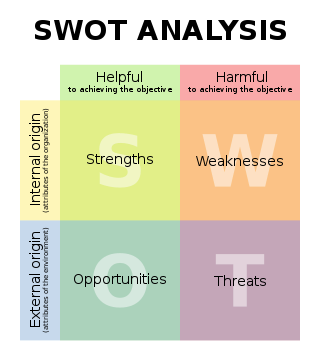Project management is the process of supervising the work of a team to achieve all project goals within the given constraints. This information is usually described in project documentation, created at the beginning of the development process. The primary constraints are scope, time and budget. The secondary challenge is to optimize the allocation of necessary inputs and apply them to meet pre-defined objectives.

A work-breakdown structure (WBS) in project management and systems engineering is a deliverable-oriented breakdown of a project into smaller components. A work breakdown structure is a key project management element that organizes the team's work into manageable sections. The Project Management Body of Knowledge defines the work-breakdown structure as a "hierarchical decomposition of the total scope of work to be carried out by the project team to accomplish the project objectives and create the required deliverables."

The program evaluation and review technique (PERT) is a statistical tool used in project management, which was designed to analyze and represent the tasks involved in completing a given project.
Strategic planning is an organization's process of defining its strategy or direction, and making decisions on allocating its resources to attain strategic goals.

In strategic planning and strategic management, SWOT analysis is a decision-making technique that identifies the strengths, weaknesses, opportunities, and threats of an organization or project.
Agile software development is an umbrella term for approaches to developing software that reflect the values and principles agreed upon by The Agile Alliance, a group of 17 software practitioners in 2001. As documented in their Manifesto for Agile Software Development the practitioners value:
Adaptive management, also known as adaptive resource management or adaptive environmental assessment and management, is a structured, iterative process of robust decision making in the face of uncertainty, with an aim to reducing uncertainty over time via system monitoring. In this way, decision making simultaneously meets one or more resource management objectives and, either passively or actively, accrues information needed to improve future management. Adaptive management is a tool which should be used not only to change a system, but also to learn about the system. Because adaptive management is based on a learning process, it improves long-run management outcomes. The challenge in using the adaptive management approach lies in finding the correct balance between gaining knowledge to improve management in the future and achieving the best short-term outcome based on current knowledge. This approach has more recently been employed in implementing international development programs.
The MECE principle is a grouping principle for separating a set of items into subsets that are mutually exclusive (ME) and collectively exhaustive (CE). It was developed in the late 1960s by Barbara Minto at McKinsey & Company and underlies her Minto Pyramid Principle, and while she takes credit for MECE, according to her interview with McKinsey, she says the idea for MECE goes back as far as to Aristotle.

Business process re-engineering (BPR) is a business management strategy originally pioneered in the early 1990s, focusing on the analysis and design of workflows and business processes within an organization. BPR aims to help organizations fundamentally rethink how they do their work in order to improve customer service, cut operational costs, and become world-class competitors.
A consulting firm or simply consultancy is a professional service firm that provides expertise and specialised labour for a fee, through the use of consultants. Consulting firms may have one employee or thousands; they may consult in a broad range of domains, for example, management, engineering, and so on.

Rosabeth Moss Kanter is an American sociologist who is a professor of business at Harvard Business School. She co-founded the Harvard University Advanced Leadership Initiative and served as Director and Founding Chair from 2008 to 2018. She was the top-ranking woman—No. 11 overall—in a 2002 study of Top Business Intellectuals by citation in several sources. She was named one of the "50 most powerful women in Boston" by Boston Magazine and named one of "125 women who changed our world" over the past 125 years by Good Housekeeping magazine in May 2010.
Dice are polyhedral objects used in games for generating random numbers.
Business analysis is a professional discipline focused on identifying business needs and determining solutions to business problems. Solutions may include a software-systems development component, process improvements, or organizational changes, and may involve extensive analysis, strategic planning and policy development. A person dedicated to carrying out these tasks within an organization is called a business analyst or BA.
Organizational intelligence (OI) is the capability of an organization to comprehend and create knowledge relevant to its purpose; in words, it is the intellectual capacity of the entire organization. With relevant organizational intelligence comes great potential value for companies and organizations to figure out where their strengths and weaknesses lie in responding to change and complexity.

Scrum is an agile team collaboration framework commonly used in software development and other industries.
Oliver Wyman, LLC is an American management consulting firm. Founded in New York City in 1984 by former Booz Allen Hamilton partners Alex Oliver and Bill Wyman, the firm has more than 60 offices in Europe, North America, the Middle East, and Asia-Pacific employing over 5,000 professionals. The firm is part of the Oliver Wyman Group, a business unit of Marsh McLennan.
In organizational development, corporate diagnostics provides tools for the effective diagnosis of organizational culture, and structural and operational strengths and weaknesses.

Lynda Gratton a British organizational theorist, consultant, and Professor of Management Practice at London Business School and the founder of HSM Advisory, known for her work on organisational behaviour.
Harry Levinson was an American psychologist and consultant in work and organizational issues. He was a pioneer in the application of psychoanalytic theory to management and leadership. He linked the failure of managers to effectively contain the anxieties of workers to employee depression and low productivity.

Alan Weiss is an American entrepreneur, author, and public speaker.







